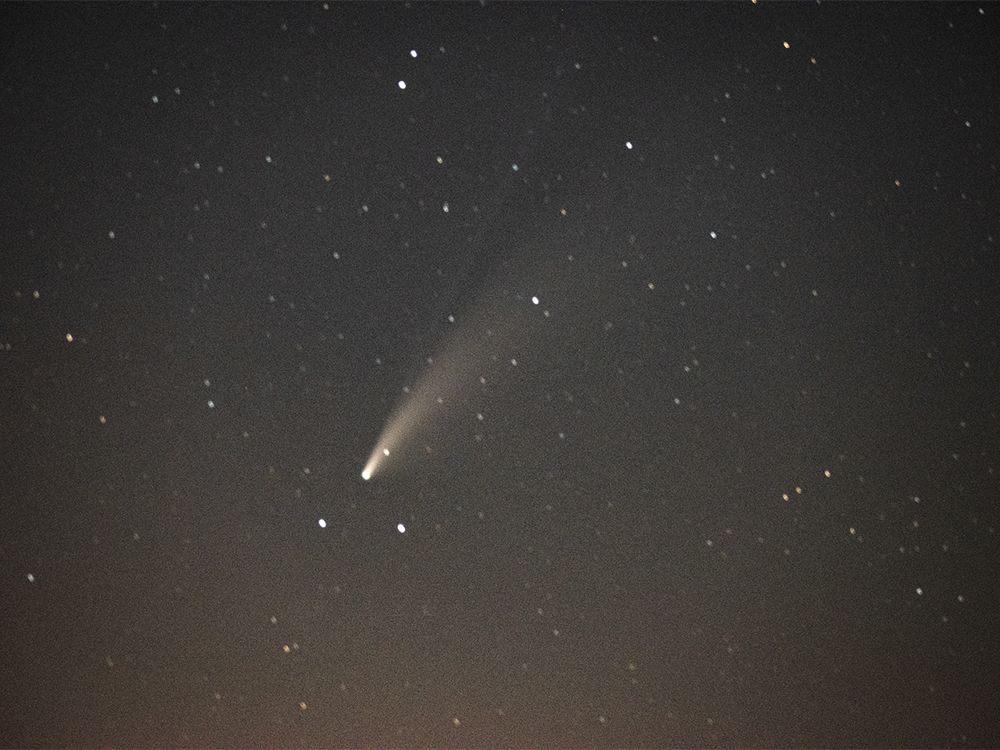UT Dallas Comets, Meet Comet NEOWISE
07.24.2020
 Editor’s Note: Amanda Siegfried, executive editor in the Office of Communications, photographed comet NEOWISE on July 18, 2020, from a rural location in North Texas near Celina. “I couldn’t see the comet by eye, or even through my camera’s zoom lens, so I pointed the camera in the area of the sky where I thought it should be and hoped for the best,” Siegfried said. Post-processing of the digital photo revealed details including the prominent dust tail and a second, fainter ion tail, pointing to roughly the one-o’clock position in this photo. Nikon D5600; 70-300 mm lens, at 82 mm; ISO 2000; f-4.8; 25-second exposure.
Editor’s Note: Amanda Siegfried, executive editor in the Office of Communications, photographed comet NEOWISE on July 18, 2020, from a rural location in North Texas near Celina. “I couldn’t see the comet by eye, or even through my camera’s zoom lens, so I pointed the camera in the area of the sky where I thought it should be and hoped for the best,” Siegfried said. Post-processing of the digital photo revealed details including the prominent dust tail and a second, fainter ion tail, pointing to roughly the one-o’clock position in this photo. Nikon D5600; 70-300 mm lens, at 82 mm; ISO 2000; f-4.8; 25-second exposure.
The COVID-19 pandemic has made 2020 a very challenging year, but this summer there was at least one beautiful bright spot.
Comet NEOWISE, short for C/2020 F3 (NEOWISE), was discovered in late March by astronomers using the Wide-field Infrared Survey Explorer (WISE) space telescope as part of NASA’s NEOWISE mission. Comet NEOWISE provided a pleasant diversion as it was visible in North American skies throughout much of July.
With all due respect to the mascot of The University of Texas at Dallas, comets are essentially “dirty snowballs” – made of rock, ice and dust – that are the detritus left over from the formation of the solar system some 4.6 billion years ago. Comet NEOWISE originated in the Oort cloud, a huge collection of ancient comets and asteroids billions of miles from Earth. Occasionally, one of those bodies is kicked out of its comfortable position and is pulled by gravity toward the sun.
“Comets like NEOWISE are cosmic time capsules of primordial ice from the dawn of our solar system,” said Dr. Mary Urquhart, a planetary scientist and associate professor in the School of Natural Sciences and Mathematics at UT Dallas.
As a comet approaches the sun, it heats up, which releases from its surface gas and dust that reflect sunlight. Observers see a comet’s head, or nucleus, as a fuzzy dot, followed by a wispy tail pluming out in the opposite direction from the sun. Like the mythical Icarus, many comets don’t survive their journey too close to the sun – they break up and disintegrate.
“We now know that comets are common, but many smaller comets are doomed by the time we see them in telescopes, such as those in NASA’s solar observation fleet. It’s a rarity that we have a comet that is bright enough to see gracing our skies here on Earth,” said Urquhart, who is head of the Department of Science/Mathematics Education.
“It was a surprise that comet NEOWISE turned out to be visible with binoculars or the unaided eye, at least for the lucky folks who live in areas with very dark skies. Unfortunately, it was a challenge to see it in metropolitan Dallas without a telescope or by capturing it with a digital camera.”
Astronomers estimate that the head of comet NEOWISE is 3 miles in diameter and that it has a long, elliptical orbit, which means it won’t revisit the inner solar system again for about 6,800 years.
“Astronomical events like eclipses and the unexpected visitation of a comet can be inspirational and can bring people together for a shared experience that may not come again in their lifetimes,” Urquhart said. “They remind us to take a break, look up and enjoy the natural wonders of the universe.”
–Amanda Siegfried



